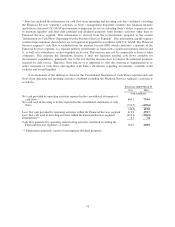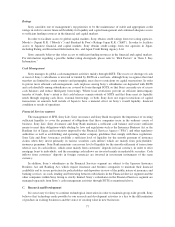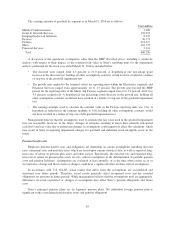Sony 2015 Annual Report Download - page 82
Download and view the complete annual report
Please find page 82 of the 2015 Sony annual report below. You can navigate through the pages in the report by either clicking on the pages listed below, or by using the keyword search tool below to find specific information within the annual report.from other sources. Actual results may significantly differ from these estimates. Sony considers an accounting
policy to be critical if it is important to its financial condition and results, and requires significant judgment and
estimates on the part of management in its application. Sony believes that the following represents its critical
accounting policies.
Investments
Sony’s investments include debt and equity securities accounted for under both the cost and equity method
of accounting. If it has been determined that an investment has sustained an other-than-temporary decline in its
value, the investment is written down to its fair value with a charge to income. Sony regularly evaluates its
investment portfolio to identify other-than-temporary impairments of individual securities. Factors that are
considered by Sony in determining whether an other-than-temporary decline in value has occurred include: the
length of time and extent to which the market value of the security has been less than its original cost, the
financial condition, operating results, business plans and estimated future cash flows of the issuer of the security,
other specific factors affecting the market value, deterioration of the credit condition of the issuer, sovereign risk,
and whether or not Sony is able to retain the investment for a period of time sufficient to allow for the anticipated
recovery in market value.
In evaluating the factors for available-for-sale securities whose fair values are readily determinable, Sony
presumes a decline in value to be other-than-temporary if the fair value of the security is 20 percent or more
below its original cost for an extended period of time (generally for a period of up to six months). This criterion
is employed as a threshold to identify securities which may have a decline in value that is other-than-temporary.
The presumption of an other-than-temporary impairment in such cases may be overcome if there is evidence to
support that the decline is temporary in nature due to the existence of other factors which overcome the duration
or magnitude of the decline. On the other hand, there may be cases where impairment losses are recognized when
the decline in the fair value of the security is not more than 20 percent or such decline has not existed for an
extended period of time, as a result of considering specific factors which may indicate that the decline in the fair
value is other-than-temporary.
When an other-than-temporary impairment of a held-to-maturity debt security has occurred, the amount of
the other-than-temporary impairment recognized in income depends on whether Sony intends to sell the security
or more likely than not will be required to sell the security before recovery of its amortized cost. If the debt
security meets either of these two criteria, the other-than-temporary impairment is recognized in income,
measured as the entire difference between the security’s amortized cost and its fair value at the impairment
measurement date. For other-than-temporary impairments of debt securities that do not meet these two criteria,
the net amount recognized in income is a credit loss equal to the difference between the amortized cost of the
debt security and its net present value calculated by discounting Sony’s best estimate of projected future cash
flows at the effective interest rate implicit in the debt security prior to impairment. Any difference between the
fair value and the net present value of the debt security at the impairment measurement date is recorded in
accumulated other comprehensive income. Unrealized gains or losses on securities for which an other-than-
temporary impairment has been recognized in income are presented as a separate component of accumulated
other comprehensive income.
The assessment of whether a decline in the value of an investment is other-than-temporary is often
subjective in nature and involves certain assumptions and estimates concerning the expected operating results,
business plans and future cash flows of the issuer of the security. Accordingly, it is possible that investments in
Sony’s portfolio that have had a decline in value that Sony currently believes to be temporary may be determined
to be other-than-temporary in the future based on Sony’s evaluation of subsequent information such as continued
poor operating results, future broad declines in the value of worldwide equity markets and the effect of
worldwide interest rate fluctuations. As a result, unrealized losses recorded for investments may be recognized
and reduce income in future periods.
82
























